Overview
Self-Managed Superannuation Funds (SMSFs) possess a unique opportunity to borrow money primarily through Limited Recourse Borrowing Arrangements (LRBAs). This mechanism allows them to leverage their assets for strategic investments, particularly in commercial properties.
While this borrowing capability opens the door to significant benefits—such as enhanced investment opportunities and potential tax advantages—it is crucial to recognize the accompanying risks.
Compliance and financial management challenges demand careful navigation by trustees.
Are you prepared to harness the full potential of your SMSF while managing these risks effectively?
Introduction
In the realm of retirement planning, Self-Managed Super Funds (SMSFs) are carving out a niche that offers unparalleled control and flexibility to investors. As Australians increasingly turn to SMSFs for their retirement savings, the ability to borrow against these funds is becoming a game-changer.
Limited Recourse Borrowing Arrangements (LRBAs) allow members to leverage their existing assets to acquire high-value investments, particularly in the commercial property sector. This trend is gaining momentum, with statistics indicating a significant rise in SMSF balances and a growing interest in tailored investment strategies.
However, with great opportunity comes great responsibility; understanding the legal and regulatory framework surrounding SMSF borrowing is crucial for avoiding pitfalls.
This article delves into the intricacies of SMSF borrowing, exploring its advantages, risks, and best practices for trustees to navigate this complex landscape effectively.
Understanding Self-Managed Super Funds (SMSFs) and Their Borrowing Capabilities
Self-Managed Superannuation Funds empower individuals to take control of their retirement savings, offering a degree of autonomy that traditional superannuation funds lack. Members of self-managed super funds have the flexibility to select a diverse range of assets, including real estate, shares, and other investments, thus tailoring their portfolios to meet personal financial goals. A notable advantage of self-managed superannuation funds is their ability to borrow money under specific conditions, primarily through Limited Recourse Borrowing Arrangements (LRBAs).
This mechanism enables self-managed super funds to leverage existing assets for investments in high-value properties or other lucrative opportunities, potentially enhancing their retirement savings.
As of 2025, around 1.1 million Australians are utilizing self-managed super funds for their retirement savings, reflecting a growing trend towards self-directed investment strategies. Recent statistics reveal that the average member balance for females has surged by 26% over the past five years, while males have experienced a 22% increase, underscoring the effectiveness of self-managed super funds in wealth accumulation.
In March 2025, new developments in self-managed super fund borrowing capabilities have emerged, enhancing the flexibility of these funds. The recent elimination of the $3 million super tax for this year has further encouraged individuals to explore self-managed super funds as a viable retirement savings option. This regulatory shift, coupled with Australia's anticipated GDP recovery in 2025, positions self-managed super funds as an attractive financial vehicle, particularly for commercial assets such as office buildings, warehouses, and retail spaces, which face fewer restrictions compared to residential real estate.
Understanding the legal and regulatory framework surrounding whether a SMSF can borrow money is crucial to avoid potential pitfalls. Compliance with the Superannuation Industry (Supervision) Act 1993 (SIS Act) is vital for maintaining the fund's status and determining borrowing capabilities while ensuring that arrangements are executed correctly. By utilizing LRBAs, self-managed super funds can strategically allocate resources toward assets that might otherwise be out of reach, thereby enhancing their financial portfolios and securing a stronger economic future.
Finance Story is dedicated to assisting clients in navigating the complexities of self-managed super fund commercial real estate ventures. Our expert guidance ensures that you build a robust case and maintain compliance with regulations, preparing you to find the right lender for your commercial asset. Case studies from Finance Story illustrate successful self-managed superannuation fund strategies, demonstrating how clients have effectively leveraged these funds to achieve their financial objectives.
For instance, one client utilized an LRBA to acquire a commercial property that significantly increased their portfolio's value, while another employed superannuation funds to invest in a diverse share portfolio, resulting in substantial growth over time. These examples highlight the importance of tailored financial solutions and the role of Finance Story in managing the complexities of borrowing and asset allocation.
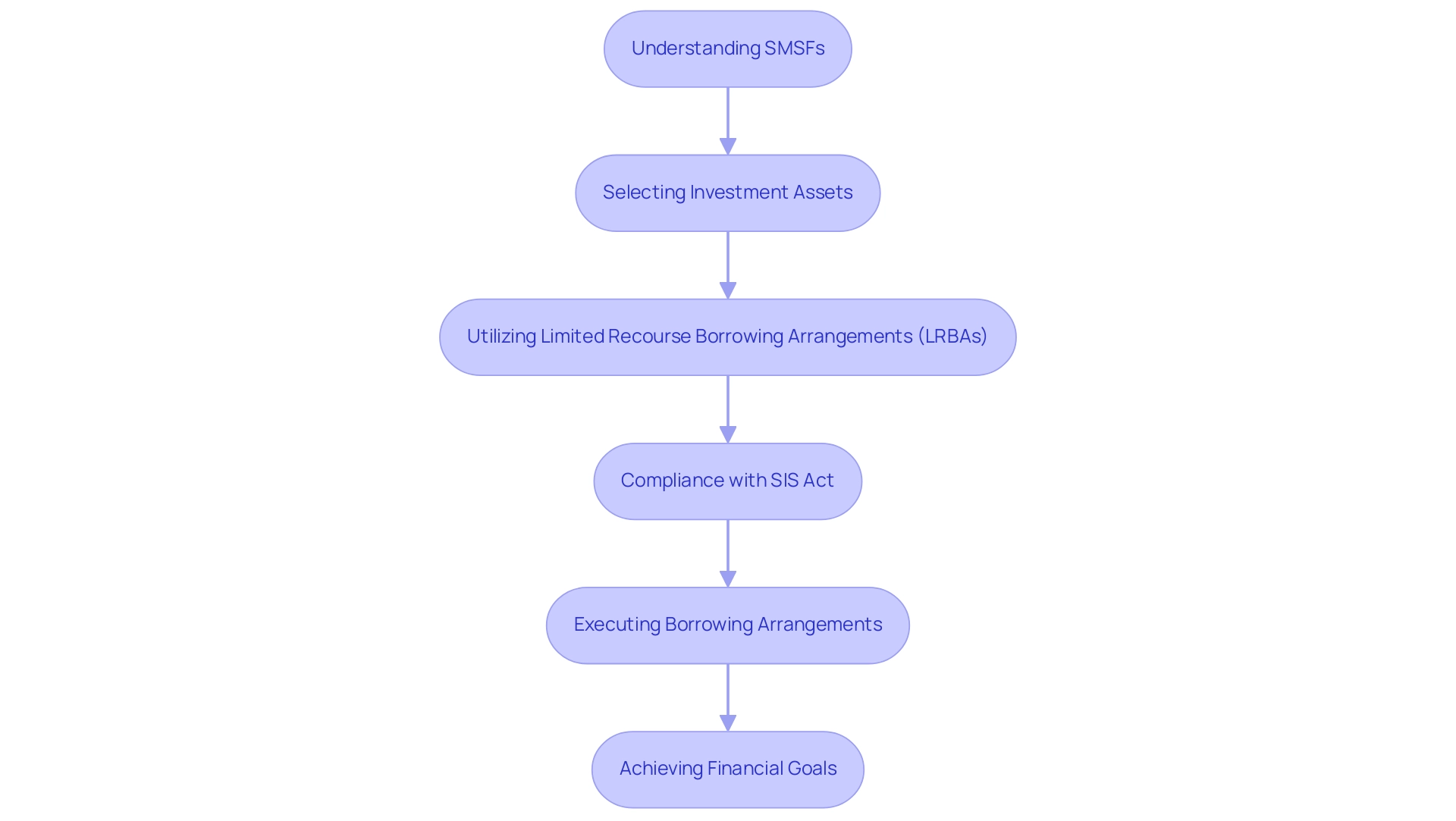
Types of Loans Available for SMSFs: Exploring Your Options
When considering borrowing options, it is crucial to understand that a Self-Managed Super Fund (SMSF) can borrow money through various avenues. The most prevalent choice is the Limited Recourse Borrowing Arrangement (LRBA), which allows the fund to secure financing for a single asset, such as real estate, while ensuring that the lender's recourse is limited solely to that asset. This structure is particularly appealing for investors aiming to expand their asset base without compromising their personal financial objectives.
As noted by Theo Chambers, Co-founder and CEO of Shore Financial, "This structure has become an essential part of the appeal for investors who want to grow their asset base in a way that doesn't interfere with their personal financial goals." As of March 2025, the landscape of SMSF borrowing continues to evolve, with over 80,000 members reporting balances exceeding $3 million by June 2024. This highlights the growing interest in these funds as a viable financial vehicle.
In addition to LRBAs, SMSFs may also explore:
- Commercial property loans, specifically tailored for obtaining business premises
- Residential property loans aimed at generating returns
Finance Story specializes in creating tailored funding solutions for both first-time buyers and seasoned investors, ensuring that clients can capitalize on various market opportunities. Furthermore, related party loans present another option, where members can lend money to their SMSF under stringent conditions, providing flexibility in financing.
Each loan type carries distinct regulations, risks, and benefits, making it essential for trustees to conduct thorough evaluations aligned with their financial strategies and goals. The median age of SMSF members is 63 years, with newly formed fund members averaging 47 years. This indicates a demographic shift towards younger investors who are increasingly utilizing SMSFs for property financing. This trend underscores the importance of personalized service, as highlighted by Finance Story's commitment to building long-term client relationships.
Their focus on understanding client needs ensures that trustees feel supported in navigating these borrowing options. Expert opinions underscore the significance of understanding these borrowing options. As noted by industry leaders, the appeal of LRBAs lies in their ability to facilitate asset growth without impacting serviceability for traditional borrowing outside the superannuation framework. This strategic advantage allows investors to navigate the complexities of SMSF borrowing effectively.
In summary, the question of whether an SMSF can borrow money highlights a variety of borrowing options, each with distinct features that can greatly affect financial results. By carefully assessing these choices, trustees can optimize their financial strategies and work towards achieving their long-term objectives. Finance Story is here to provide expert guidance, ensuring compliance and assisting in lender selection for commercial property investments.
Contact us today to explore tailored funding solutions that meet your specific needs.
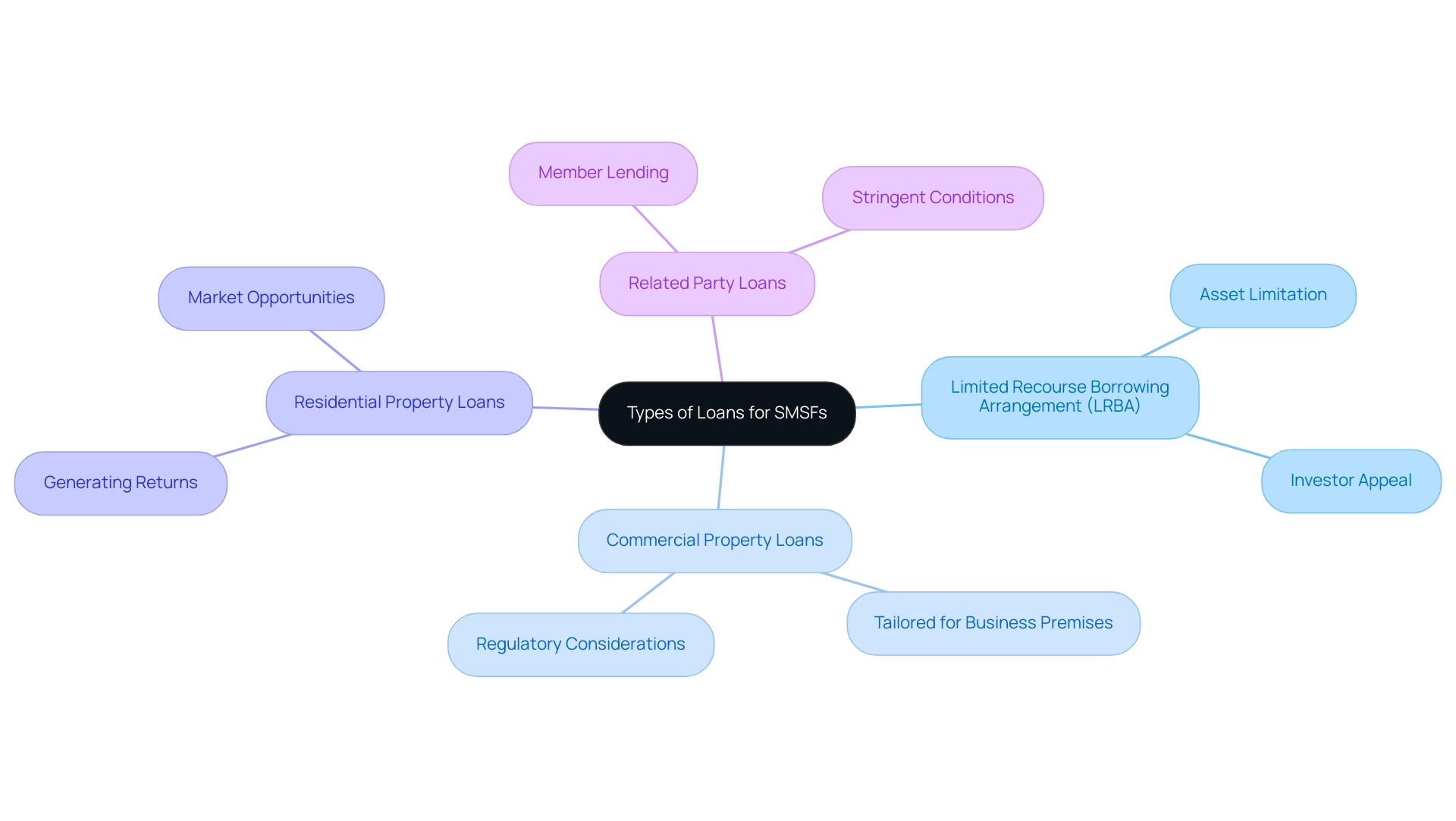
Navigating the Regulatory Landscape: Compliance Requirements for SMSF Borrowing
Navigating the regulatory landscape for SMSF borrowing is essential for trustees to understand how and when a SMSF can borrow money, as the SIS Act enforces stringent rules designed to safeguard members' retirement savings. Under these regulations, the question of whether a SMSF can borrow money arises, as self-managed superannuation funds are permitted to borrow only through a Limited Recourse Borrowing Arrangement (LRBA), which stipulates that the loan must be utilized to acquire a single acquirable asset. Furthermore, the asset in question must not be classified as a prohibited asset, such as residential real estate from a related party.
Self-managed super funds can invest in various types of commercial properties, including office buildings, warehouses, and retail premises, which have fewer restrictions compared to residential property investments.
The Australian Taxation Office (ATO) plays a pivotal role in monitoring compliance with these borrowing regulations. Recent updates indicate that the ATO is increasingly vigilant in its oversight, particularly in light of the transition to MySuper products, which has significant implications for SMSF borrowing practices. This transition necessitates that trustees remain informed about how these changes affect their borrowing strategies, especially regarding whether a SMSF can borrow money.
Non-compliance can lead to severe penalties, including administration penalties, disqualification of the fund, and even civil and criminal repercussions. Statistics from 2025 reveal that a significant number of self-managed super funds have faced penalties due to non-compliance with rules on how a SMSF can borrow money, highlighting the critical need for trustees to remain informed about the evolving regulatory environment.
At Finance Story, we understand that leveraging SMSFs for commercial property investments requires expert guidance. Our team is dedicated to helping small business owners create a strong case for compliance and navigate the complexities of lender selection. We emphasize that understanding compliance requirements is not just a legal obligation but a strategic necessity for superannuation fund trustees.
Shaun Backhaus, Director at DBA Lawyers, emphasizes, "This article is for general information only and should not be relied upon without first seeking advice from an appropriately qualified professional." A recent report on the self-managed superannuation fund industry growth indicates a marked increase in both asset values and compliance rates, suggesting that well-informed trustees are better positioned to navigate these complexities. Case studies illustrate that self-managed superannuation funds adhering to the SIS Act borrowing regulations have successfully avoided penalties and capitalized on growth opportunities, reinforcing the importance of diligent compliance.
As the self-managed superannuation fund landscape continues to evolve, it is crucial to understand if and how a SMSF can borrow money under the latest SIS Act borrowing regulations. Trustees must ensure their borrowing practices, particularly regarding whether a SMSF can borrow money, align with legal requirements to protect their members' interests and secure their financial futures. With Finance Story's customized solutions, small business owners can confidently invest in commercial assets through their SMSFs.
BOOK A CHAT.
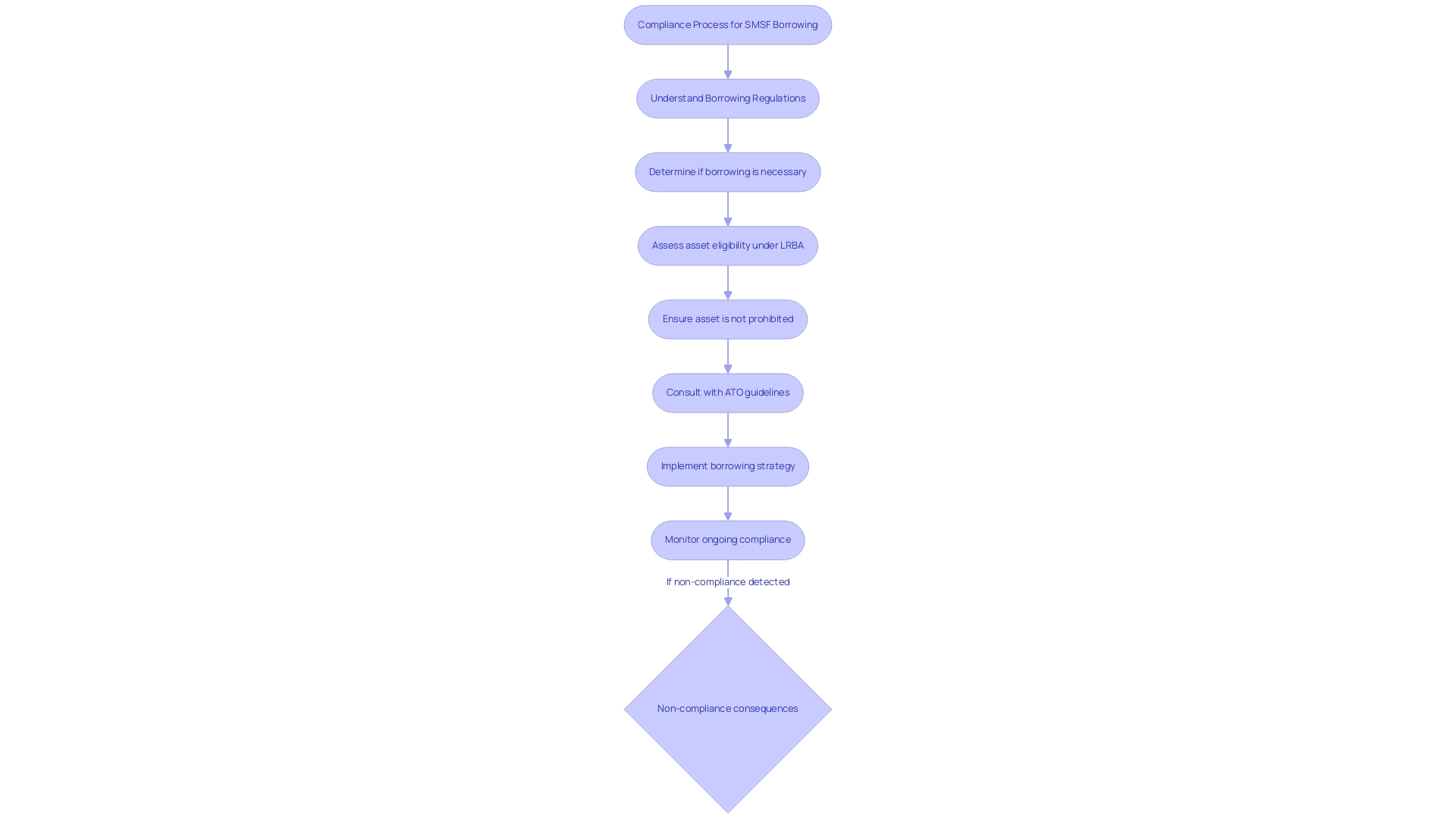
The Advantages of SMSF Borrowing: Unlocking Investment Opportunities
The ability to borrow through a Self-Managed Superannuation Fund (SMSF) raises an important question: can an SMSF borrow money to unlock significant opportunities for fund members, particularly in commercial assets such as office buildings and warehouses? One of the key advantages lies in leveraging existing superannuation savings to acquire high-value assets. This strategy not only diversifies the fund's asset portfolio but also significantly enhances the potential for higher returns compared to conventional methods.
In fact, statistics indicate that over 74% of assets in self-managed superannuation funds are held in a mix of Australian listed shares, cash, term deposits, unlisted trusts, non-residential real property, and Limited Recourse Borrowing Arrangements (LRBA) assets. This showcases the diverse financial landscape available to these funds.
Moreover, the question of whether an SMSF can borrow money can yield considerable tax benefits. Rental income and capital gains from assets held within the fund are typically taxed at a lower rate than personal income, allowing members to maximize their returns. This tax efficiency is especially beneficial in the current financial climate, where strategic financial choices can lead to significant wealth accumulation.
The adaptability inherent in self-managed super funds also enables trustees to customize their strategies to align with long-term financial objectives. For instance, many SMSFs have achieved higher returns through borrowing, with more than 65% of SMSFs having existed for over a decade, indicating a trend towards sustained growth. As rthomson1 observes, 'Well over 80,000 members now have over $3 million by the time the 30/06/24 figures are crunched,' emphasizing the increasing trend of significant self-managed superannuation fund balances.
Expert views highlight the benefits of utilizing superannuation savings, with financial analysts noting that an SMSF can borrow money to improve asset opportunities and offer a route to increased financial security. Case studies demonstrate how SMSFs can borrow money to effectively unlock financial opportunities, leading to impressive returns that exceed those of traditional avenues. For instance, Finance Story, a Melbourne-based boutique mortgage brokerage, focuses on offering customized financial solutions, including self-managed superannuation fund loans, and has access to a comprehensive portfolio of private, boutique commercial investors.
This illustrates how personalized support can result in successful financial outcomes. As of March 2025, the environment for self-managed superannuation fund borrowing raises the question of how an SMSF can borrow money, offering new opportunities for growth and financial contribution that astute fund members can take advantage of. Moreover, Finance Story's committed lending associate in the UK for expat loans enhances its service options, providing members with a variety of funding opportunities.
Testimonials from satisfied clients, such as Natasha B from VIC, affirm the effectiveness of Finance Story's bespoke mortgage services, stating, 'I will definitely be recommending your business to anyone. We are finished with the constant worry.' This reflects Finance Story's commitment to guiding clients through their financing journey.
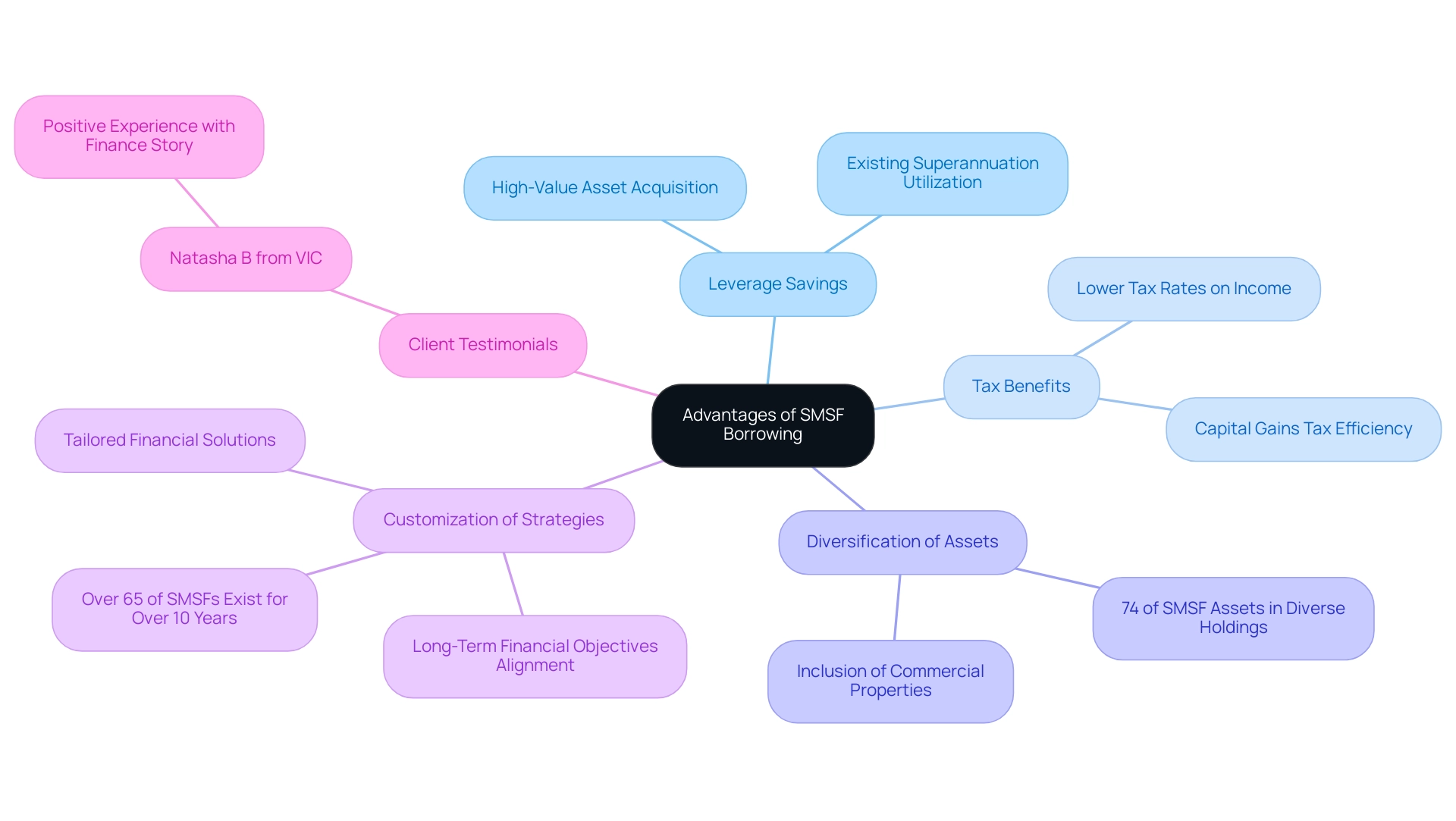
Understanding the Risks: What to Consider Before Borrowing with Your SMSF
While the question of whether a SMSF can borrow money presents various advantages, it also carries significant risks that must be carefully managed. A primary concern is over-leveraging, particularly regarding whether a SMSF can borrow money beyond its repayment capacity. This scenario can create financial strain, especially if the investment underperforms or if market fluctuations negatively affect property values.
In 2025, statistics indicate that a notable percentage of SMSFs are grappling with liquidity challenges, underscoring the importance of ensuring that rental income sufficiently covers loan repayments. This situation can restrict cash flow for other essential obligations, further complicating the financial landscape for trustees. Moreover, the risks associated with borrowing in a self-managed superannuation fund raise the question of whether a SMSF can borrow money, as underscored by recent trends in the lending market.
With major banks such as National Australia Bank and ANZ pulling back from self-managed superannuation fund property investment lending, the choices accessible to trustees have become restricted. This shift emphasizes the importance of selecting the right lending partner in the current lending landscape, particularly in understanding how a SMSF can borrow money, as Commonwealth Bank remains the only major bank still offering self-managed superannuation fund loans. Additionally, it is important to note that SMSF loans have LVR restrictions of up to 90% and typically have higher interest rates starting from 6.99%, as highlighted by Theo Chambers.
The performance of SMSF loans has been robust, with arrears tracking below the Standard & Poor's Performance Index for Australian prime mortgage loans over the past five years. This trend suggests that while self-managed superannuation funds have generally maintained strong financial positions, the potential for future transitions to retirement could impact loan arrears. Furthermore, the average annual capital gains in the Australian property market range between 5% - 10%, providing context on potential investment returns and associated risks, especially when considering how a SMSF can borrow money. Engaging with financial advisors from Finance Story can provide valuable insights into managing liquidity challenges and mitigating the risks of over-leveraging, ensuring that SMSFs remain on a stable financial footing.
Additionally, trustees must remain vigilant regarding compliance with regulatory requirements, as non-compliance can lead to severe penalties, including the disqualification of the fund. Therefore, it is crucial for trustees to conduct thorough due diligence and seek professional advice to navigate the complexities of self-managed superannuation fund borrowing effectively. For tailored guidance and to create a strong case for compliance, BOOK A CHAT with Finance Story today.

Limited Recourse Borrowing Arrangements (LRBAs): A Closer Look
Limited Recourse Borrowing Arrangements (LRBAs) exemplify how a self-managed superannuation fund (SMSF) can borrow money to secure financing for the acquisition of a single asset, such as real estate. A defining feature of LRBAs is that the lender's recourse is confined solely to the asset purchased. In the event of a default, the lender can only claim the asset itself, thereby protecting the other holdings within the SMSF.
This protective mechanism is particularly appealing to trustees who wish to mitigate risks associated with leveraging their superannuation funds. As of 2025, the usage of LRBAs within SMSFs has seen a notable increase, with approximately 30% of SMSFs engaging in this borrowing strategy. This uptick reflects a growing trend among trustees to utilize LRBAs as a means of enhancing their asset portfolios. Notably, 85% of self-managed superannuation fund members are 45 years or older, indicating that a significant portion of this demographic is actively engaging with LRBAs.
However, it is crucial to recognize that LRBAs raise the question of whether a SMSF can borrow money, as they come with stringent compliance requirements. SMSFs must establish a separate trust to hold the acquired asset, ensuring that the asset is distinctly separated from the fund's other holdings. Additionally, maintaining adequate liquidity to meet loan repayments is essential; failure to do so could jeopardize the fund's financial stability.
Expert analysis indicates that while LRBAs can offer significant benefits, such as increased investment opportunities and potential tax advantages, they also carry inherent risks. Recent discussions have cautioned that the combination of accrual-based taxation and SMSF borrowing could amplify financial risks within the superannuation system. Financial experts emphasize the importance of thorough due diligence and strategic planning when considering LRBAs.
For example, a recent case study highlighted a female member of a self-managed super fund who successfully utilized an LRBA to purchase a commercial property, resulting in a 10.1% return on investment—an impressive leap from the previous year's 0.6% return. This case underscores the potential for significant financial growth through well-executed borrowing strategies, particularly as female self-managed superannuation fund member balances increased by 26%, reflecting a growing financial empowerment among this demographic.
In light of recent discussions surrounding self-managed superannuation fund regulations, it is imperative for trustees to understand if and how a SMSF can borrow money, as well as to stay informed about compliance requirements and industry trends. The self-managed superannuation fund sector continues to evolve, with ongoing growth and increasing participation from diverse demographics, including a notable rise in female members. As the landscape shifts, understanding the nuances of LRBAs will be vital for SMSF trustees aiming to leverage their funds effectively while navigating the complexities of the financial environment.
Additionally, Finance Story is available to offer expert advice, assisting you in building a solid case for compliance and locating the appropriate lender for your commercial ventures, including office buildings, warehouses, and retail spaces. It is essential for the government to address the exemption allowing self-managed superannuation funds to borrow to finance investments to mitigate risks associated with the proposed tax, as highlighted by Senator Nick McKim, who noted that this legislation is a lost opportunity to address growing economic inequality in Australia. BOOK A CHAT.
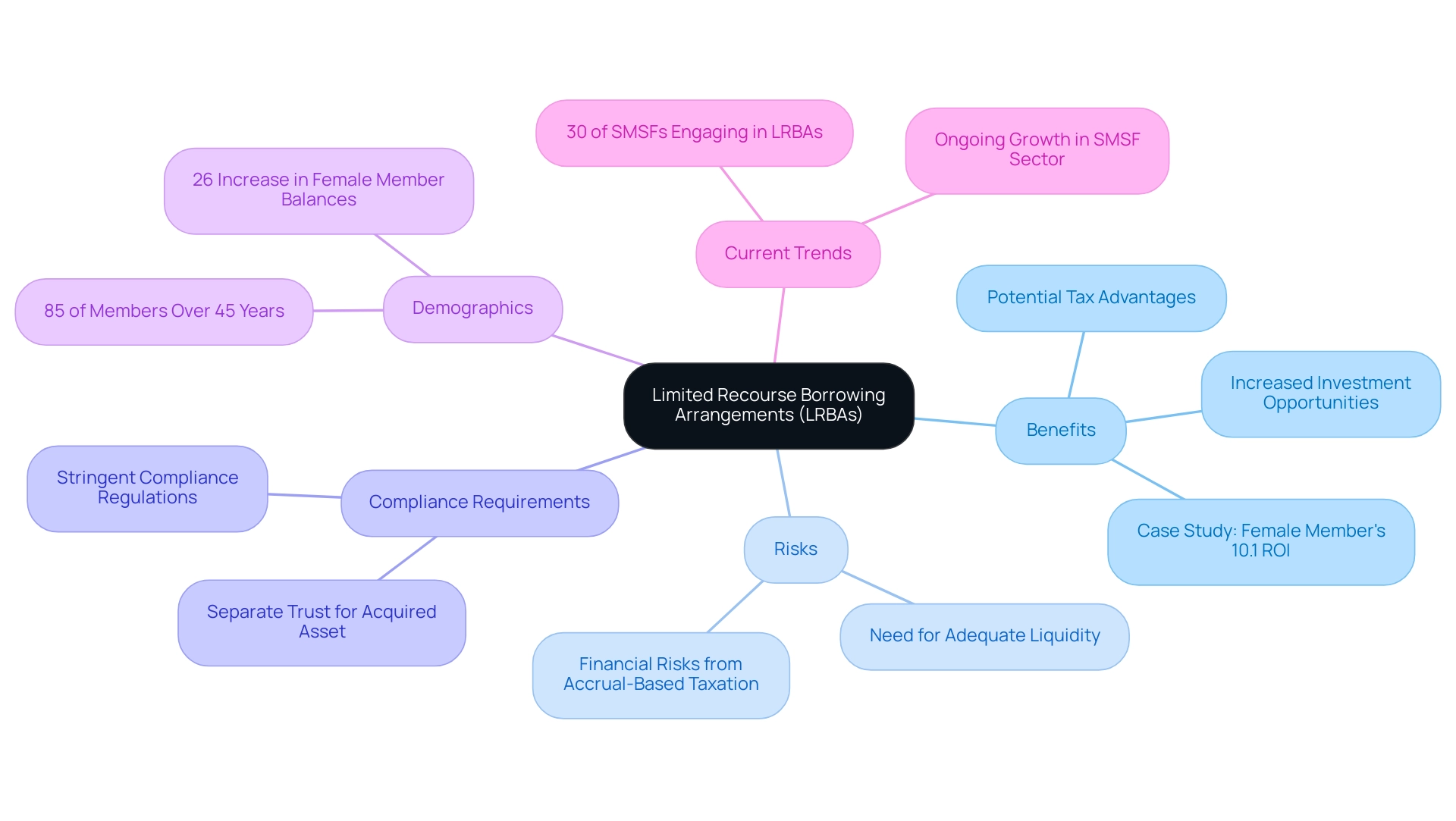
Borrowing from Related Parties: Rules and Considerations
When considering financing options for Self-Managed Superannuation Funds (SMSFs), a common question arises: can a SMSF borrow money from related parties, particularly for investments in commercial properties such as office buildings, warehouses, and retail premises? The Australian Taxation Office (ATO) permits self-managed superannuation funds to engage in related party loans under strict conditions. This raises an important question: can a SMSF borrow money while ensuring that these loans are conducted on an arm's length basis? This stipulation mandates that the terms of the loan—such as interest rates and repayment schedules—reflect those typically offered by third-party lenders, ensuring fairness and compliance, especially regarding how a SMSF can borrow money.
A significant restriction to note is that self-managed super funds are prohibited from using borrowed funds to purchase residential property from related parties. This limitation is crucial for trustees to understand, as it directly impacts the types of allocations that can be made using related party loans. To maintain compliance with ATO guidelines and avoid potential penalties, trustees must meticulously document all related party loans, particularly in cases relevant to whether a SMSF can borrow money, including the rationale for the terms set.
As of March 2025, statistics indicate that a notable percentage of SMSFs are engaging in borrowing from related parties, prompting the inquiry: can a SMSF borrow money? In fact, the total worth of Australian superannuation is approximately $4.1 trillion, underscoring the considerable magnitude of self-managed superannuation fund contributions. However, it is vital for trustees to remain aware of the associated risks, such as single asset risk and liquidity challenges, which can arise when evaluating whether a SMSF can borrow money.
A recent case analysis titled "Challenges and Risks of Self-Managed Superannuation Fund Real Estate Investment" highlighted the intricacies associated with self-managed superannuation fund real estate ventures, emphasizing the importance of strategic planning and adherence to self-managed superannuation fund regulations to mitigate possible financial consequences.
Expert opinions underscore the necessity of adhering to ATO guidelines when determining if a SMSF can borrow money through related party loans. Financial advisors, including Theo Chambers, suggest that 'investing in real estate through your superannuation could be a powerful strategy to build wealth and secure your future.' This perspective reinforces the potential advantages of self-managed superannuation fund property acquisition.
Advisors recommend that trustees ensure all transactions are conducted at arm's length to protect the integrity of the fund and its assets. By understanding these guidelines and applying best practices, trustees can effectively utilize related party borrowing as part of their broader financial strategy, demonstrating how a SMSF can borrow money. Furthermore, Finance Story is committed to providing expert advice and tailored solutions for clients navigating self-managed super fund commercial real estate ventures, including building a solid case for compliance and assisting in selecting suitable lenders.
To explore how we can assist you further, BOOK A CHAT with us today.
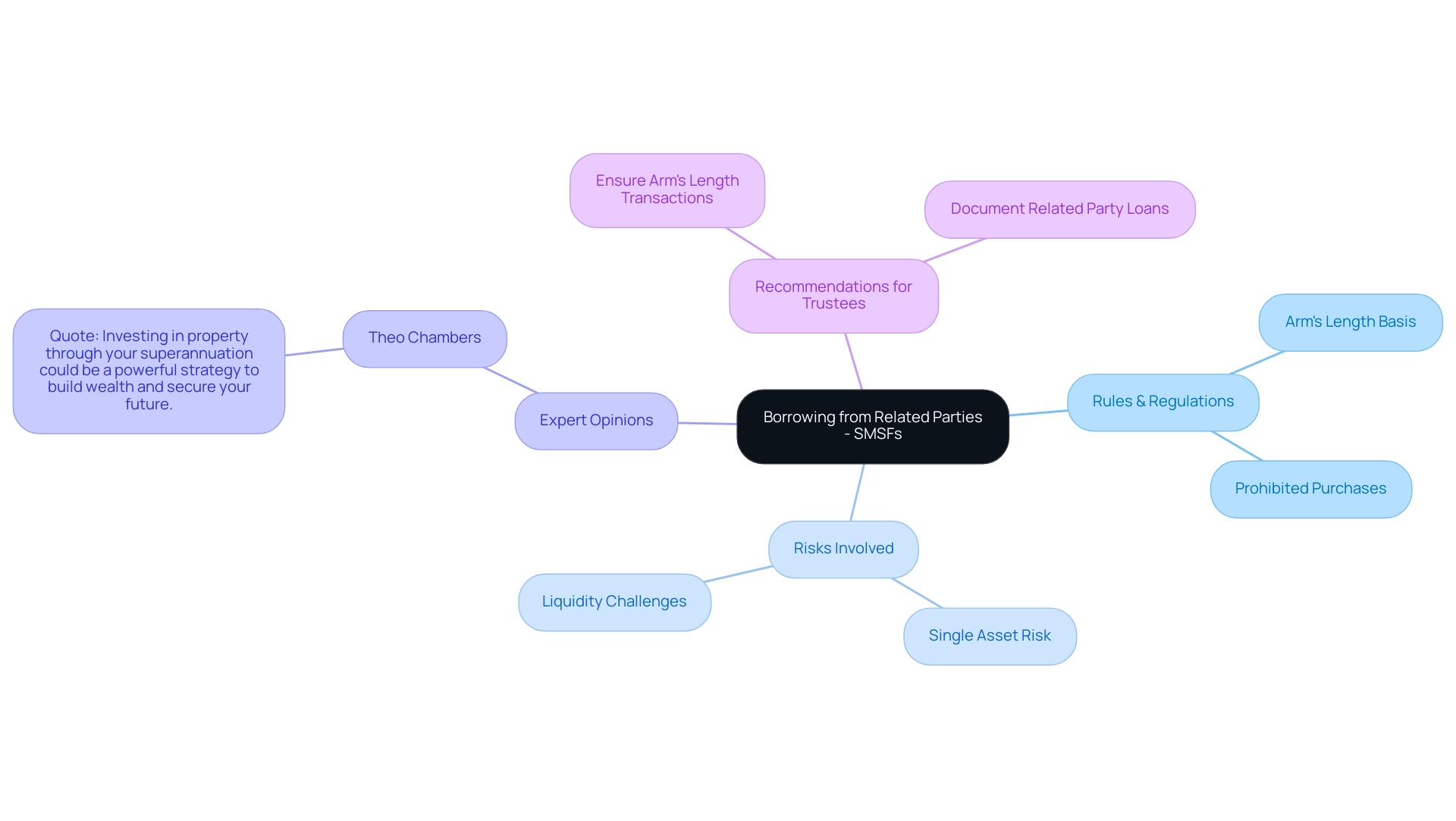
Best Practices for Managing SMSF Loans: Tips for Trustees
Effectively managing loans for a self-managed superannuation fund raises the critical question: how can a SMSF borrow money? This process necessitates meticulous planning and adherence to established best practices. Trustees must perform regular evaluations of their financial strategies to ensure that any borrowing aligns with their long-term fiscal goals, particularly regarding whether a SMSF can borrow money for commercial real estate endeavors. Unlike residential properties, commercial property investments come with fewer restrictions, providing trustees with greater flexibility.
Accurate record-keeping of all loan agreements and transactions is crucial. This practice not only demonstrates compliance with regulatory requirements but also safeguards the integrity of the fund.
Establishing a clear repayment plan is another vital component. It ensures that loan repayments remain manageable and do not compromise the fund's liquidity. In 2025, a significant percentage of trustees are seeking professional advice regarding self-managed superannuation fund loans, reflecting the complexities involved in this area. Engaging with financial consultants or accountants who specialize in self-managed super funds, such as those at Finance Story, can offer invaluable insights into how a SMSF can borrow money, assisting trustees in navigating these complexities effectively.
For instance, a recent case study highlighted the importance of having an exit strategy for SMSFs. This illustrates how trustees can prepare for unforeseen circumstances that may necessitate winding up the fund. Such a proactive approach equips clients with a clear understanding of the steps involved and emphasizes the significance of having a valid death benefit nomination.
Moreover, understanding the financial implications of setting up a self-managed super fund is essential. Trustees must assess whether the expenses related to establishing and overseeing a self-managed super fund align with their financial circumstances and objectives. With Australian superannuation valued at $4.1 trillion, the scale of self-managed super funds underscores their importance in the financial landscape.
Trustees should also be aware of the risks associated with self-managed superannuation fund real estate investment, including single asset risk, liquidity challenges, regulatory complexity, and market volatility. By applying these best practices, trustees can enhance the performance of their self-managed super fund while minimizing the risks associated with borrowing. Understanding how a SMSF can borrow money ultimately secures a more stable financial future. As Theo Chambers pointed out, "Investing in real estate through your superannuation could be a powerful strategy to build wealth and secure your future."
Furthermore, recent news regarding Thinktank aiding the acquisition of a commercial asset by two self-managed superannuation funds exemplifies the practical application of self-managed superannuation fund loans in achieving financial objectives. This reinforces the customized guidance provided by Finance Story.
BOOK A CHAT to explore how Finance Story can assist you in navigating your SMSF commercial property investments.
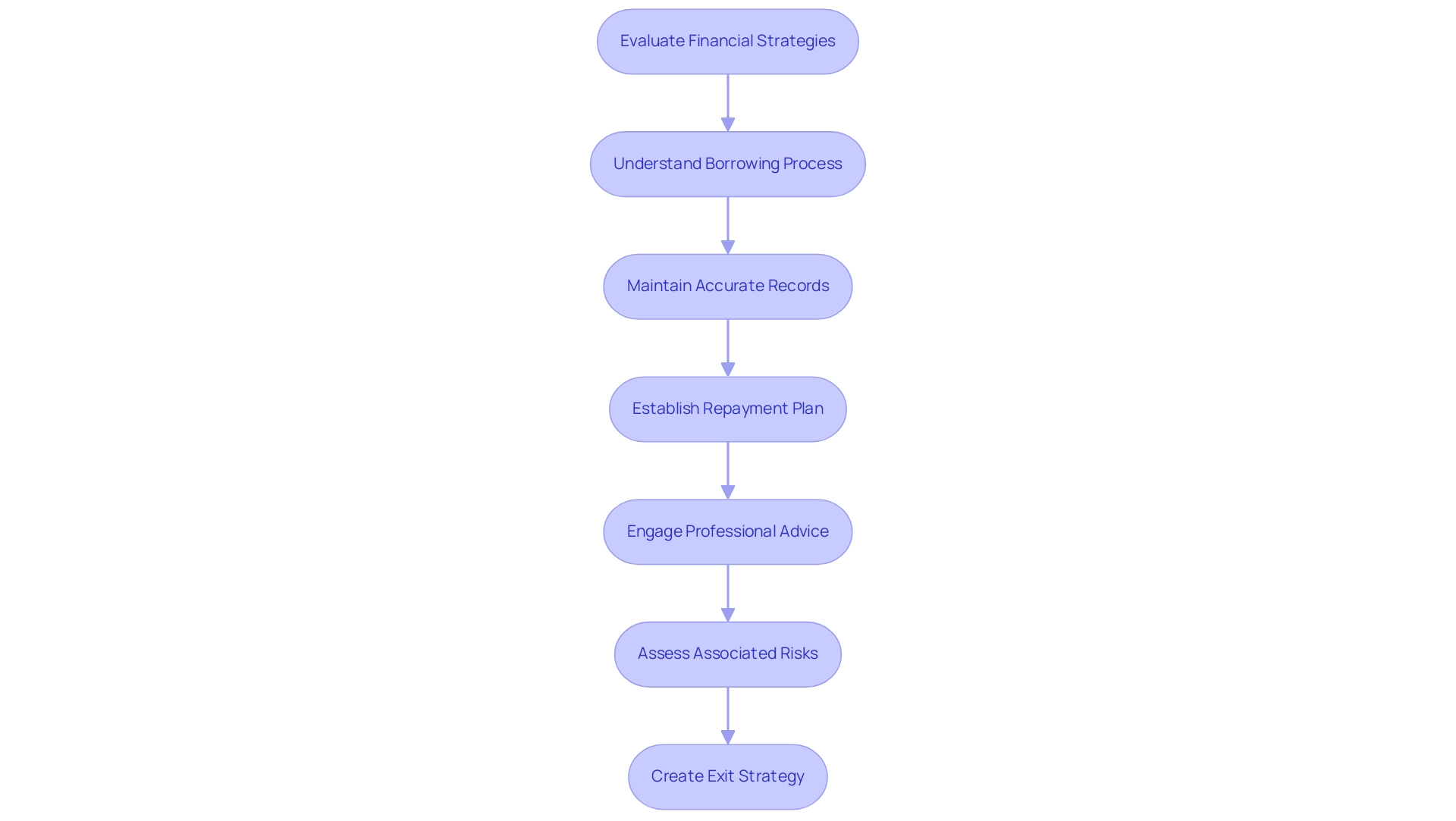
Conclusion
The exploration of Self-Managed Super Funds (SMSFs) and their borrowing capabilities reveals a transformative opportunity for Australians seeking greater control over their retirement savings. By leveraging Limited Recourse Borrowing Arrangements (LRBAs), SMSF members can invest in high-value assets such as commercial properties, effectively enhancing their investment portfolios and potentially increasing their returns. The recent surge in SMSF balances and the growing trend toward tailored investment strategies underscore the effectiveness of these funds in wealth accumulation.
However, the advantages of SMSF borrowing come with inherent risks and regulatory responsibilities. Understanding the legal framework, particularly the stipulations outlined in the Superannuation Industry (Supervision) Act 1993 (SIS Act), is critical for trustees to avoid pitfalls and ensure compliance. As the SMSF landscape continues to evolve, staying informed about the latest regulations and market trends will empower trustees to navigate the complexities of borrowing effectively.
Ultimately, the potential for substantial financial growth through SMSF borrowing hinges on informed decision-making and strategic planning. Engaging with expert guidance can provide trustees with the necessary tools to harness these opportunities while mitigating risks. As more Australians embrace SMSFs as a viable option for retirement savings, the importance of thorough understanding and diligent management cannot be overstated. By leveraging the advantages of SMSF borrowing wisely, trustees can secure a stronger financial future for themselves and their beneficiaries.

